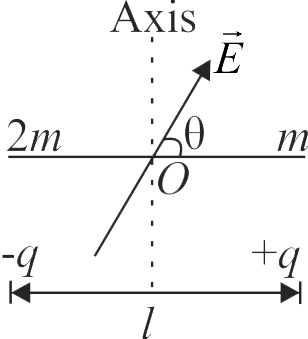358158 A dipole comprises of two charged particles of identical magnitude \(q\) and opposite in nature. The mass ' \(m\) ' of the positive charged particle is half of the mass of the negative charged particle. The two charges are separated by a distance ' \(l\) ' the dipole is pivoted at the mid point of dipole axis. If the dipole is placed in a uniform electric field \(\vec{E}\); in such a way that dipole axis makes a very small angle with the electric field \(\vec{E}\). The angular frequency of the oscillations of the dipole when released is given by
358158 A dipole comprises of two charged particles of identical magnitude \(q\) and opposite in nature. The mass ' \(m\) ' of the positive charged particle is half of the mass of the negative charged particle. The two charges are separated by a distance ' \(l\) ' the dipole is pivoted at the mid point of dipole axis. If the dipole is placed in a uniform electric field \(\vec{E}\); in such a way that dipole axis makes a very small angle with the electric field \(\vec{E}\). The angular frequency of the oscillations of the dipole when released is given by
358158 A dipole comprises of two charged particles of identical magnitude \(q\) and opposite in nature. The mass ' \(m\) ' of the positive charged particle is half of the mass of the negative charged particle. The two charges are separated by a distance ' \(l\) ' the dipole is pivoted at the mid point of dipole axis. If the dipole is placed in a uniform electric field \(\vec{E}\); in such a way that dipole axis makes a very small angle with the electric field \(\vec{E}\). The angular frequency of the oscillations of the dipole when released is given by
358158 A dipole comprises of two charged particles of identical magnitude \(q\) and opposite in nature. The mass ' \(m\) ' of the positive charged particle is half of the mass of the negative charged particle. The two charges are separated by a distance ' \(l\) ' the dipole is pivoted at the mid point of dipole axis. If the dipole is placed in a uniform electric field \(\vec{E}\); in such a way that dipole axis makes a very small angle with the electric field \(\vec{E}\). The angular frequency of the oscillations of the dipole when released is given by
